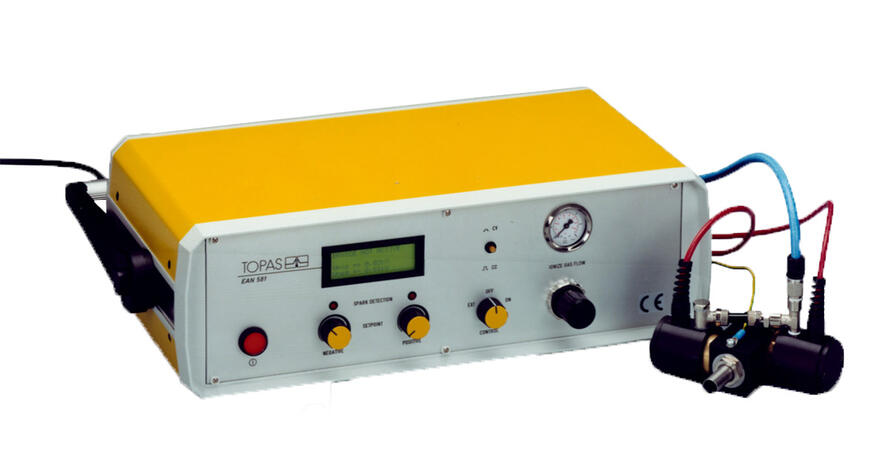EAN 581 Aerosol Neutralizer
Electrostatic Aerosol Neutralizer EAN 581 for generation of positive and/or negative ions for neutralisation or unipolar charging of aerosols
The BElectrostatic Aerosol Neutraliser EAN 581 from Topas conditions the charge distribution of test dusts and other aerosols, like required in ISO 11155-1 and DIN 71460-1. Charge equilibrium can be controlled by mixing positive and negative ions in a precise manner.
The mechanical interaction of particles, especially solid ones, may cause undesirable levels of electrostatic charge. Test dusts must be generated with a high degree of reproducibility for instance when evaluating aerosol separation techniques such as cyclones, filters or impactors. Comparable results can only be obtained at controlled and similar charge levels.
Standards
VDI 3491-6
ISO 11155-1
DIN 71460-1
download
product sheet EAN 581Benefits
- production of positiv and/or negative ions for neutralisation or for specific charging of aerosols
- operation requires no occupational radiation protection since no ionising radiation originates
- integrated spark detection
- easy to integrate into existing test systems
Applications
- aerosol neutralisation (especially for highly charged aerosols as typical for aerosols generated by dry dispersion)
- systemic unipolar-positiv or -unipolar-negative charging of aerosol particles
- reproducible evalutation of the performance of filter media, filter elements and other aerosol separation techniques (cyclones, impactors, ...)
- quality assurance
- research and development
The Electrostatic Aerosol Neutralizer EAN 581 is based on the corona discharge principle and consists of a mixing chamber with two separate ionization heads and a control unit. Positive and negative ions are generated by two ion blowers and consecutively mixed into the aerosol stream within the mixing chamber. A source of compressed, particle free air is connected to both of the ionization heads and mains voltage applied to the power cord.
The special design of the mixing chamber guarantees nearly ideal mixing conditions allowing the highest (dis)charging efficiency. The exchange of air ions onto the surface of the particles causes changes in the final charge remaining on the particle as it leaves the unit.
| Parameter title | Unit | Value |
|---|---|---|
| purpose of conditioning | - | neutralisation or unipolar charging of aerosols |
| setting parameter | - | ionisation voltage | ionisation current | system pressure of compressed air |
| setting range | - | ± 0 ... 10 kV | ± 0 ... 150 µA | 0,5 ... 6,0 bar |
| setting method | - | manual |
| operating medium, gas/air | - | particle-free, dry compressed air |
| operating medium, gas/air - compressed air supply | bar | max. 8 |
| operating medium, gas/air - compressed air supply | L/min | 8 ... 200 |
| operating medium, aerosol | L/min | max. 250 |
| power supply | - | 100 ... 260 V AC; 2 A/F |
| power consumption | W | approx. 50 |
| hose connector, aerosol inlet | mm | Ø 8 (outer diameter) |
| hose connector, aerosol outlet | mm | Ø 14 (outer diameter) |
| connector, compressed air | - | coupling plug NW 7,2 |
| dimensions (w × h × d) | mm | 480 × 160 × 260 |
| weight | kg | 8,7 (control unit 7,5; mixing chamber with ionisation heads 1,2) |
- field strength gauge
-
Marquard A, Meyer J, Kasper G Characterization of unipolar electrical aerosol chargers—Part II:: Application of comparison criteria to various types of nanoaerosol charging devices J. Aerosol Sci. 37 (2006) 9, 1069 - 1080
dx.doi.org/10.1016/j.jaerosci.2005.09.002
